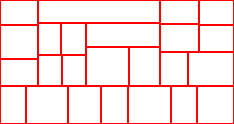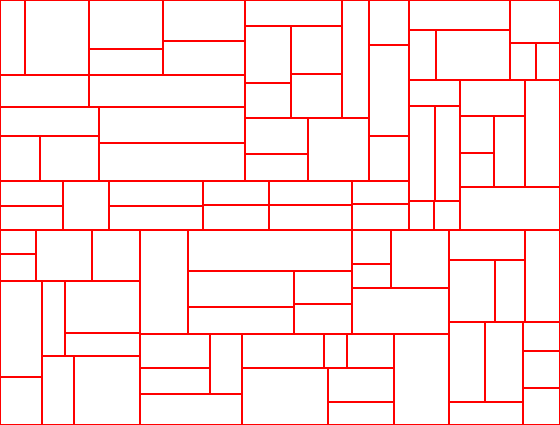Towards my goal of interesting dungeon generation. I started looking into various techniques and the first thing to catch my eye was a visual explanation of BSP Dungeon Generation.
This appeals to me so I wrote out some code to do just that:
namespace Morgemil.Test open Morgemil.Map open Morgemil.Math module BspGenerator = ///The smallest room possible let MinRoomSize = Vector2i(23, 23) ///Average more towards this size in theory let TargetRoomSize = Vector2i(41, 41) type Tree = | Node of Tree * Tree | Leaf of Rectangle type Axis = | Horizontal | Vertical ///Choose the opisite Axis let Opposite(ax : Axis) = match ax with | Axis.Vertical -> Axis.Horizontal | Axis.Horizontal -> Axis.Vertical let CanDivideHorizontal(area : Rectangle) = area.Width > MinRoomSize.X * 2 let CanDivideVertical(area : Rectangle) = area.Height > MinRoomSize.Y * 2 let CanDivide(area : Rectangle) = CanDivideHorizontal area || CanDivideVertical area ///Chooses an axis to split on. Keeps ratios fairly square. let AxisToDivide (ax : Axis) (area : Rectangle) = match area with | _ when area.Height >= area.Width * 2 -> Axis.Vertical | _ when area.Width >= area.Height * 2 -> Axis.Horizontal | _ when not (CanDivideHorizontal area) -> Axis.Vertical | _ when not (CanDivideVertical area) -> Axis.Horizontal | _ -> Opposite(ax) ///Rectangle * Rectangle let Divide (area : Rectangle) (ax : Axis) (rng : RNG.DefaultRNG) = match ax with | Axis.Horizontal -> let rng_width = RNG.Range rng (MinRoomSize.X) (area.Width - MinRoomSize.X) let first = Rectangle(area.Position, Vector2i(rng_width, area.Height)) let second = Rectangle(area.Position + Vector2i(rng_width, 0), area.Size - Vector2i(rng_width, 0)) (first, second) | Axis.Vertical -> let rng_height = RNG.Range rng (MinRoomSize.Y) (area.Height - MinRoomSize.Y) let first = Rectangle(area.Position, Vector2i(area.Width, rng_height)) let second = Rectangle(area.Position + Vector2i(0, rng_height), area.Size - Vector2i(0, rng_height)) (first, second) ///Recursively divides an area into a Binary Space Partitioning Tree let rec BSP (rng : RNG.DefaultRNG) (area : Rectangle) (ax : Axis) = let prob = (decimal ((area.Size - MinRoomSize).Area) / decimal ((TargetRoomSize - MinRoomSize).Area)) let divide = CanDivide(area) && RNG.Probability rng prob match divide with | false -> Tree.Leaf area | true -> let opAx = AxisToDivide ax area let (first, second) = Divide area opAx rng Tree.Node(BSP rng first opAx, BSP rng second opAx) //This is essentially a constant since it takes no arguments let DungeonGenerator = let dungeonFloor = TileDefinition(1, "Floor", "Dungeon floors are often trapped", false, true, TileType.Land) let BspResults = ///Inject the seed in the future let seed = System.Random().Next() BSP (RNG.SeedRNG(seed)) (Rectangle(Vector2i(0, 0), Vector2i(234, 124))) Axis.Horizontal ///flatterns a BSPTree into Rectangle List let rec flatten treeNode = match treeNode with | Tree.Leaf(rect) -> [ rect ] | Tree.Node(e1, e2) -> [ flatten e1 flatten e2 ] |> List.concat ///(0,0) (90,0) (180,0)... let chunksToCreatePositions = flatten BspResults ///Given the area of the chunk to create let CreateRoomChunk(roomArea : Rectangle) = ///border is empty tiles and the contained area is dungeon floor let ChooseTile(tilePosition : Vector2i) = match tilePosition with | _ when tilePosition.X = roomArea.Left || tilePosition.X = roomArea.Right || tilePosition.Y = roomArea.Top || tilePosition.Y = roomArea.Bottom -> TileDefinition.Default | _ -> dungeonFloor ///Maps each coordinate in the room into a tile let tileArray = roomArea.Coordinates |> Seq.map (ChooseTile) |> Seq.toArray Chunk(roomArea, tileArray) chunksToCreatePositions |> Seq.map (CreateRoomChunk) |
Here is the entry point
[<EntryPoint>] let main argv = let createdBspDungeon = Morgemil.Test.BspGenerator.DungeonGenerator let filename2 = "map_test2.bmp" let dungeonDraw2 = Morgemil.Test.DungeonVisualizer.Visualize(createdBspDungeon) dungeonDraw2.Save(filename2) //System.Console.ReadKey() |> ignore 0 // return an integer exit code |
I made a quick visualizer to make a bitmap of the generated chunks
namespace Morgemil.Test open System.Drawing module DungeonVisualizer = open Morgemil.Map open Morgemil.Math ///Draws chunks to the minimum image space necessary let Visualize(chunks : seq<Chunk>) = let minimumImageSize = chunks |> Seq.map (fun chun -> chun.Area) |> Seq.reduce (+) ///Not a true FP structure. So modify at will. let resultingImage = new Bitmap(minimumImageSize.Width, minimumImageSize.Height) let DrawTile(tile : TileDefinition, pos : Vector2i) = let tileColor = match tile with | _ when TileDefinition.IsDefault tile -> Color.Red | _ -> Color.White resultingImage.SetPixel(pos.X, pos.Y, tileColor) let DrawChunk(chunk : Chunk) = chunk.Area.Coordinates |> Seq.map (fun xy -> (chunk.Tile xy, xy - minimumImageSize.MinCoord)) |> Seq.iter (DrawTile) chunks |> Seq.iter (DrawChunk) resultingImage |
Here is a sample result with the relevant parameters set:
///The smallest room possible let MinRoomSize = Vector2i(23, 23) ///Average more towards this size in theory let TargetRoomSize = Vector2i(80, 80) let seed = 67 BSP (RNG.SeedRNG(seed)) (Rectangle(Vector2i(0, 0), Vector2i(560, 425))) Axis.Horizontal |
What this does is define distinct areas in which to place distinct things without overlap. Those could be unique rooms, enough space for a specific kind of room generator, or just a way to determine room density. My next post on this subject will be on placing and connecting rooms.

